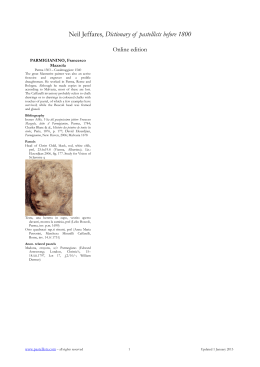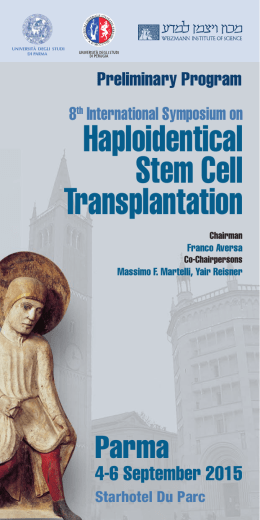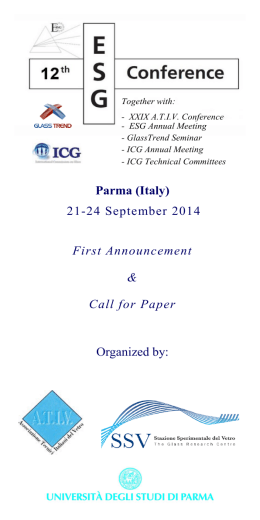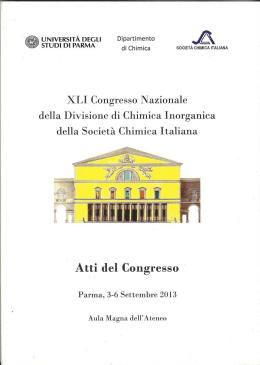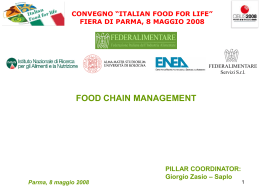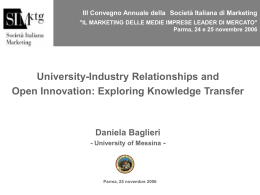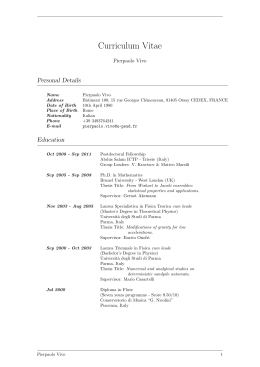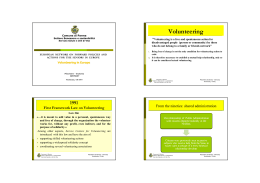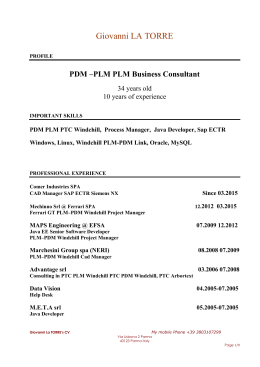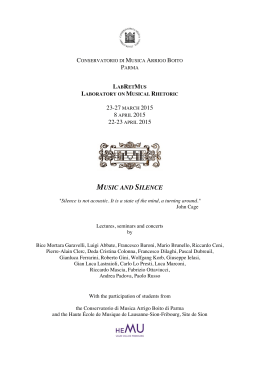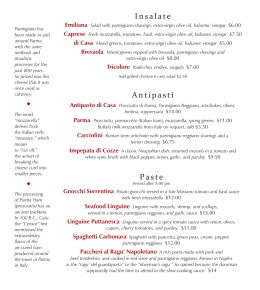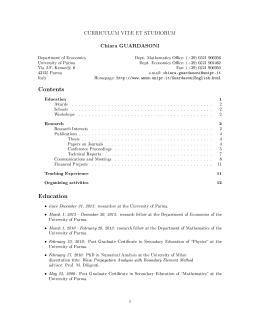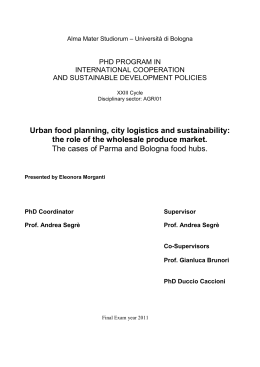Animal Welfare at slaughter 18 – 21 February, 2014. Parma (Italy) Brochure Training activities on Animal Welfare mainly for EU Member States under the 'Better Training for Safer Food' Initiative. Service Contract N. 2012 96 04 Contractor: lstituto Zooprofilattico Sperimentale dell'Abruzzo e del Molise "G.Caporale" Sub-contractors: Aarhus University (DK), Scotland’s Rural College (UK), Università degli Studi di Milano (I) When and Where The training course will be held on 18-21 February, 2014, in Parma (PR), Italy. Photo: www.itineraemilia.com Parma is a city, located in the Emilia-RomagnaRegion, famous for its architecture, surrounding countrysideand food-industry. The city hosts the University of Parma, one of the oldest universities in the World. Perfect picture of a comfortable provincial city, Parma offers locals through pretty piazzas and elegant cafés; beautifully preserved monuments and exhibitions of delicious food. Parma “City of Art and City of Music” reminds the name of Giuseppe Verdi; his music and art is present in the story of the city and in its atmosphere. Originally Etruscan, Parma achieved importance as a Roman colony across the Via Emilia. As the Roman authority declined, the city passed to the Goths, the Lombards and then the Franks. Like most northern Italian cities, in the 11th century, Parma was nominally a part of the Holy Roman Empire created by Charlemagne, but locally governed by its bishops; the first was Guibodus. In the subsequent struggles between the Papacy and the Empire, Parma was usually a member of the Imperial party. During the following centuries, it was under the Visconti family, the Sforza’s, the French and finally the Papacy until 1545. Parma was ruled by the Farnese family in name of the Pope from 1545 to 1731, until the Bourbons took control, leading in a period of peace and intensive cultural activity. At the beginning of the 19th century, following Napoleon’s incursions into northern Italy, Parma experienced a period of instability that ended with Italian unification. During the II World War, Parma was very active in the partisanresistance. 1 The city has some very interesting monuments to see and visit. Duomo Battistero Photo: Ambiente Regione Emilia Romagna Photo. www.Turismo.Parma.it The Parma’s Duomo, consecrated in 1106, has a classic Lombard-Romanesque style in its outside. Inside, there are some real treasures: up in the dome, Antonio Correggio’s Assunzione dellaVergine (Assumption of the Virgin) is a kaleidoscopic of cherubims and angels, while down in the southern transept, Benedetto Antelami’s Deposizione (Descent from the Cross; 1178) relief is considered a masterpiece of its type. The Battistero(1196-1307), on the south side of the same square hosting the Duomo, is a work of Benedetto Antelami. This is an octagonal pink-marble building, combining Romanesque and Gothic styles,including a set of figures representing the months, seasons and signs of the zodiac. The National Gallery displays Parma’s main art collection. Itis possible to find there paintingsby local artists, Correggio and Parmigianino, and by Fra Angelico, Canaletto and El Greco. Parma hosts also an important theatre: Teatro Farnese. Rebuilt to original plans after Second World War bombing, thetheatre was built in 1618 by Giovanni Battista Aleotti. It is almost entirely made out of wood in a Baroque-style. Coming over Piazza della Pace, the monumental Palazzo della Pilotta is hard to miss. Supposedly named after the Spanish ball game of “pelota” that was once played within its walls, it was originally built for the Farnese family between 1583 and 1622. Bombed in the Second World War, it has been rebuilt and today houses several events and expositions. 2 Teatro Farnese Photo: www.Turismo.Parma.it w On the site of the ancient Roman forum, Piazza Garibaldi is a lively centerdivided by Parma's main east-west artery, Via Mazzini, and its continuation, Strada della Repubblica. On the north side of this square, there is the Palazzo del Governatore, Governor's Palace, dating from 13th century. Today it hosts municipal offices, expositions and cultural events. Behind the Palazzo del Governatore, the visitor can find the Chiesa di Santa Maria della Steccata. The church has inside some of Parmigianino’s most extraordinary work, notably the frescoes on the arches above the altar. Many members of the ruling Farnese and Bourbon families lie buried here. Palazzo del Governatore Photo: http://www.palazzodelgovernatore.it/ www.flickr.com 3 Accomodation Participants, tutors, and speakers will be hosted at: Hotel Parma & Congressi Via Emilia Ovest, 281/A 43126 Parma, Italy Phone: +39 0521 676011 Email: [email protected] Website: www.hotelparmaecongressi.it Meals All meals, including coffee breaks, are foreseen. All the extra are not included. Breakfast includes: sweet and savoury buffet; fresh juices; 1 hot drink (coffee, tea, cappuccino, chocolate, etc.) Lunches and dinners at Hotel Parma & Congressi consist of both warm and cold buffets with starters/salads, different main courses and desserts. The restaurant serves international cuisine with a strong local influence. Vegetarian needs have already been considered for both lunches and dinners. In case of specific alimentary requirements, we kindly ask to inform the Technical Secretariat. Everything not mentioned has to be considered an extra. Hotel Parma & Congressi: cafè and restaurant www.flickr.com 4 Social Events On Thursday 20 February 2014, a social dinner will be served at the Restaurant “Trattoria Corrieri”, Parma. Trattoria Corrieri restaurant www.flickr.com In the same day a guided tour of the city will be organised. Photo: Krister462 www.flickr.com 5 Conference centre, Technical Secretariat and services The course will be held in the fully equipped Conference Centre provided by the hotel: direct phone line Wi-Fi Internet audio-visual equipment slide projector amplifier system fixed and mobile microphones. The technical assistance will be always available in. During the whole duration of the course, the personnel in charge of the Technical Secretariat, currently speaking English, Spanish and French, will be available to offer the participants all the necessary support (general information, logistics, program, material etc.). A Secretariat area will be equipped with computers, Internet access, printer and other supplies to guarantee an efficient organisation. 6
Scarica
